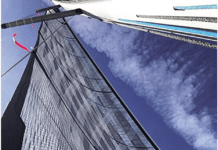Brass Plumbing Nipples
Okay, now not only am I confused, so is one of the managers at my local West Marine store.
Go into any West Marine store and in the plumbing section look at the bronze nipples. The shelving labels all say bronze. Now look at their 1999 Master Catalog, page 449. Under item A, nipples, I quote, Note: we cannot source bronze nipples, and so we offer brass instead. Items in the catalog have the same item number as those on the store shelves that are labeled bronze.
I brought this to the attention of one of the managers. He was as bewildered as I, so he made a phone call. Seems that the nipples are really red brass and the person to whom he was speaking in explaining away the labeling of bronze on the shelves said that some people call red brass bronze. I have a Ford truck but I don’t call it a Chevy!
What gives? Are these red brass/bronze nipples safe to use with real bronze plumbing? What will happen to this mixture after 10 years with saltwater flowing through it?
Or should I just give up and do it all in PVC at half the cost and weight?
T.O. Galloway
Springfield, Virginia
Brass is an alloy of copper and zinc. Zinc makes the alloy stronger and less expensive. The amount of zinc usually ranges anywhere up to about 50%. For example, naval brass is 60% copper (Cu) and 39% Zinc (Zn); yellow brass is 65% Cu and 35% Zn. Neither should be used underwater as they can dezincify, i.e., lose the zinc and fail. However, this can be prevented if connected to a large metal area about 0.2 volts lower on the galvanic scale. With a nipple, this isn’t practical, but, you wouldnt use a nipple underwater anyway.
Red brass is 85% Cu and 15% Zn. In his authoritative book, Metal Corrosion in Boats, author Nigel Warren states, with respect to dezincification, A brass with less than 15% [zinc] is usually immune. It would appear that red brass is right on the cusp.
As a side note, admiralty brass is 71% Cu, 28% Zn and 1% tin (Sn), in which the tin helps inhibit dezincification; and aluminum brass is 76% Cu, 22% Zn and 2% aluminum (Al).
Bronze is also a copper alloy. But so-called manganese bronze is misnamed and should be called a brass. Its composition is 58% Cu, 39% Zn, 1% Sn, 1% Iron (Fe) and 0.3% manganese (Mn). Its high zinc content makes it also unsuitable for underwater use. A real and better bronze for marine application is silicon bronze-96% Cu, .8 Fe, 1.5% Zn, 2% silicon (Si), .75% Mn, and 1.6% Sn. And there are zinc-free bronzes, too.
That said, use of brass nipples inside the boat is probably OK, even with saltwater flowing through them, but check them periodically anyway. They may well last a long time.
The situation could be different if the fitting were underwater and electrically connected (via seawater) to other more noble fittings that could cause the brass to dezincify, even though Warren says brasses with less than 15% are immune.
Lastly, we double-checked with West Marine management and were told that bronze nipples indeed are not available. We know not why.
Steel and Aluminum Hulls
In the advent of the popularity of the steel and aluminum hull, I think a lot of us PS readers would love to know the pros and cons of either hull.
Jean Pierre
Austin, Texas
Well, this is a complicated question. But well take a crack at it, albeit a brief one.
The principal advantages of a metal hull are strength. If youre worried about holing the boat in a collision with a coral head or container that has fallen off a ship, steel offers the best chance of surviving. Aluminum less so.
The problem with metal hulls is, of course, corrosion. Youve got to be meticulous about hunting out corrosion and eradicating it quickly. For protection of steel hulls, one relies almost entirely on coatings-primers and paint. Because most metal boats rust from the inside out, the entire interior of the boat must be accessible for periodic inspection.
Corrosion in aluminum is more difficult to detect as it creates a hard-to-see white powder rather than distinctive rust colors. Unlike steel, however, aluminum doesn’t have to be painted-witness the popularity of uncoated aluminum French cruising boats. Either way, wed use a corrosion test meter to monitor the hull.
Unfortunately, there are no real production builders of metal boats in this country. Ones only recourse now is to buy a used metal boat, or commission a custom or semi-custom one. If you scan the market, you will probably find that a good percentage of them come from Europe. Due to a lack of natural timber in the Netherlands, the Dutch have for years favored steel construction. Due to lower demand, prices generally are not out of line compared to fiberglass.







































